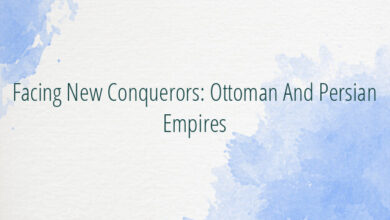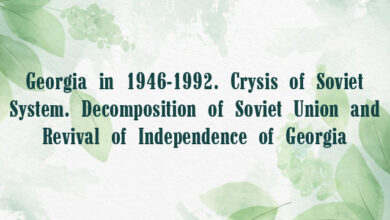
Georgia in the Beginning of Feudal Decomposition. (XVIII cen.)
The XVIII cen. began again with unified internal and external political condition for Georgia. There was a permanent internal war in Western Georgia. Turks were widening their influence there. Slave-trade was still on wide scale, slaves were sold in the slave market of Ottoman-Turks Empire.
East Georgia, as the vassal country of Iran of Sephevids, had to participate in the wars, held by this country. Struggle with rebelled Afghan tribes against Iranians was especially hard, during which many Georgian warriors and two Georgian kings were killed. Afghans also were hardly damaged by Georgians too. As says one of the authors of that time, Afghanian warriors considered Georgians as the most powerful rivals.
In 1709, when Georgian king, Giorgi XI was fighting in Afghanistan, his nephew, Vakhtang VI was appointed as his assistant in Kartli. Vakhtang was a famous statesman and culture supporter, poet and scientist. During the period of his government Kartli was on the way to ascent: the central government was strengthened, roads were arranged, bridges and irrigating channels were building, minting improved, arose trade-handicraft, the deserted after wars places were mastered again.
Arrangement of internal situation of Kartli was supported by Law Code, which was worked out by Vakhtang and was created according to Georgian Justice of the XI-XVI cen. and various foreign Juridical patterns.
With the leadership of Vakhtang, intensive scientific and literatural activity began. In 1709 the first Georgian Printing-House was established in Tbilisi, where ecclesiastical and civil books were printed. In 1712, there was printed “Knight in the Panther’s Skin” of Rustaveli at the first time, with the basic scientical research. “Kartlis Tskhovreba” collection and others were also edited and completed with the new materials.
The well-deserved representative of scientific school of Vakhtang VI was his son, Vakhushti (1696-1757), who’s fundamental work “Inventory of Georgian Kingdom” comprised the unique facts about history of Georgia and geography. This Issue was also added with the valuable cartographical materials.
At the same time with building and cultural activity, Vakhtang had to create new armies of nobility and transfer them in Iran, to complete the armies struggling against Afghans.
In 1716 Shah of Iran confirmed Vakhtang VI as the king of Kartli. At that time Kingdom of Sephevids was already weakened. At its borders stood Turkey and Russia in Transcaucasus. Vakhtang hoped that Russia, which was of one religion would help Georgia to revive independence. He made a secret agreement with the Emperor of Russia, Peter I, that considered the war against Iran together. So, in 1722 the army of Russia passed Caspian Sea coast and directed to South. Vakhtang VI, according to the plan, invaded Shah dominions with 30 000 warriors to join Russians, but it didn’t happen. Peter I suddenly changed his plans and moved back, that put the king of Kartli in difficulty. Angry Shah, who obviously saw the “treachery” of Vakhtang, ordered to dismiss him f rom the throne and gave the throne of Kartli to the king of Kakheti, Constantine II. In 1723 Constantine took Tbilisi with the hired army of Dagestanians. The struggle caused a large damage to the town. At the same time Turks began invasions from West. Vakhtang VI couldn’t stay in Georgia any more and had to escape to Russia. Armies of Ottoman-Turks occupied Tbilisi. Constantine II tried to struggle but he was killed.
In 1723-1735 Turks were dominating in East Georgia, and then, revived Iranian armies exiled Turks and established their government in the country. Georgians were fighting as against Turks so against Iranians, but liberating activity was disturbed by permanent feudal internal wars, which were held at the same time with the foreign struggles. The country was ruined from intensive military activities.
Beside the Ottoman and Iranian occupation and internal problems, invasions of Dagestanian groups in East Georgia was strengthening, which caused a large damage to the population. Georgians were fighting against Ottoman-Turks, Iranians and Dagestanians. These struggles were led by the younger brother of Constantine II, Teimuraz II. Shah of Iran was forced to make serious concessions to Georgians. In 1744 Teimuraz restored Kartli and Kakheti kingdoms, which after 1723 were abolished. The king of Kartli became Teimuraz II, and the king of Kakheti became his son, Erekle II.
They governed East Georgia at first as vassals of Iran, but then when Shah of Iran was killed by the conspirators in 1747, and there set anarchy in Iran, Kartli and Kakheti kingdoms got back their political independence.
After the death of Nadir-Shah, the long-term wars between the kingdoms, eracted on the ruins of his Empire, began. Georgians with the leadership of Erekle II, were mostly the winners in these wars. They not only defended their independence, but made some neigboring Khanates obey. Erekle showed himself as a clever general and a brave warrior. After the death of his father, Teimuraz II (1762), he became the king of the integral Kartli-Kakheti, or a whole East Georgia.
Victory of Georgians caused a big resonance in West Europe. There were articles in the French and German newspapers, the authors of which praised Erekle II and supposed that he would manage to occupy Iran, where the bloody internal wars took place.
The condition in Imereti Kingdom got comparably better. Its king, Solomon I (1752-1784) was vigorously struggling for the strength of the central governance and for liberating the country from the dominance of Turkey. He prohibited also slave-trade. The government of Ottoman-Turks, obviously didn’t like such policy of Solomon I. Ottoman-Turkish armies invaded Imereti several times, but they failed.
In 1768-1774 Erekle and Solomon supported Russia in the war against Turkey, but in spite of this, that Erekle defeated the military forces of Akhaltsikhe Viliety, he couldn’t succeed because of the betrayal of Russian General of Transcaucasia. In 1774 with the Pax with Turkey, Russia recognized souvereignty of Ottoman-Turks on West Georgia, but there was one condition, if Sultan would refuse the tributes from Imereti.
In the 50-70s of the XVIII cen. there shaped a definite rise in East Georgia. For the release of peasants conditions there were adopted a lot of laws, with which the condition of agricuture got comparably better. The mining revived in East Georgia. New enterprises were open, where the hired employment was widely used. The first manufacturings were established. Erekle II tried his best to put Georgia on the European way of development. In the period of his reign, there already appeared the decomposition of feudal relations in Kartli-Kakheti Kingdom. The part of peasants liberated from the serfdom and became the free producers. The role of rich Tbilisian merchants rose in the society life, single persons from the low level promoted on the high state ranks.
In the culture and education sphere, two seminaries and other educational institutions were open. In 1782 the first Georgian original play was performed in Tbilisi. From Georgian poets of that period, David Guramishvili (1705-1792) and Besik Gabashvili (1750-1791) are to be notified.
From the beginning of the 80s, the situation of East Georgia was aggravated again. One of the reasons for it was the permanent invasions of Daghestanians. They robbed the population, kidnapped the captives and sold them on the slave-markets of Ottoman-Turks and North Caucasus. All regions of East Georgia emptied from the invasions of Daghestanians.
In such condition, Erekle II decided to strengthen the situation with Russia again. In 1783, in the Russian fortress Georgievsk, the representatives of Russia Empire and Kartli-Kakheti signed the Treaty, according to which, East Georgia passed under the Russian protection. Georgians accepted the supremacy of Russian Emperor and refused the independent external policy. On its side, Russia promised to defend Georgia from the enemies, for which two Russian battalions with two cannons had to stand there. Also, Russia promised not to interfere with the internal affairs of Georgia. Royal Throne remained in the hands of Erekle and his descendants.
Georgievsk Treaty didn’t bring any particular goodness to Georgia, but the negative result was big. Governing circles of iran and Ottoman-Turks, who were disturbed by entering of Russia in Transcaucasia opposed Erekle II. Invasions of Daghestanians strengthened. One of the strongest owner of Daghestan, Omar-Khan successfully invaded Georgia with his army of 20 thousand warriors in 1785 Russian battalions couldn’t repel Daghestanians and Russia took its forces from Georgia and Erekle II stayed alone. In the meantime, the struggle for integrity of Iran was over. The head of the state became the founder of Kajar dinasty, Agha-Mohamed-Khan. In 1795 he invaded Transcaucasia with the huge army for revival of Iranian governance there. Erekle II, according to the Treaty, asked Russia for help, but he got nothing except promises. In the meantime, Agha-Mohamed-Khan came to Georgia with the army of 35 thousand warriors and after the bloody struggle, occupied Tbilisi on September 12, 1795. Iranians destroyed the city and captured its 10 thousand inhabitants.
After this tragedy, the situation of Kartli-Kakheti was more aggravated. In 1798 Erekle II died and his son, Giorgi XII (1798-1800), who was weak and passive, set on the Throne.
At this time, Russian government decided to annex East Georgia. In 1799 Russian armies entered Georgia again. And after the death of Giorgi XII, in 1801, Russian Emperor, Alexander I declared his manifesto on abolishment of Kartli-Kakheti Kingdom and its annexation with Russia. Manifesto hypocritically said, that this Act was dictated with only the care of the interests of Georgian people. The place in Tbilisi, where the Manifesto was publicly declared, was sieged by Russian army and artillery. And those from the listeners, who protested the abolishment of the Kingdom, were arrested on the place.
Thus, the period of Russian governance in Georgia began.
by Dr. George Anchabadze




